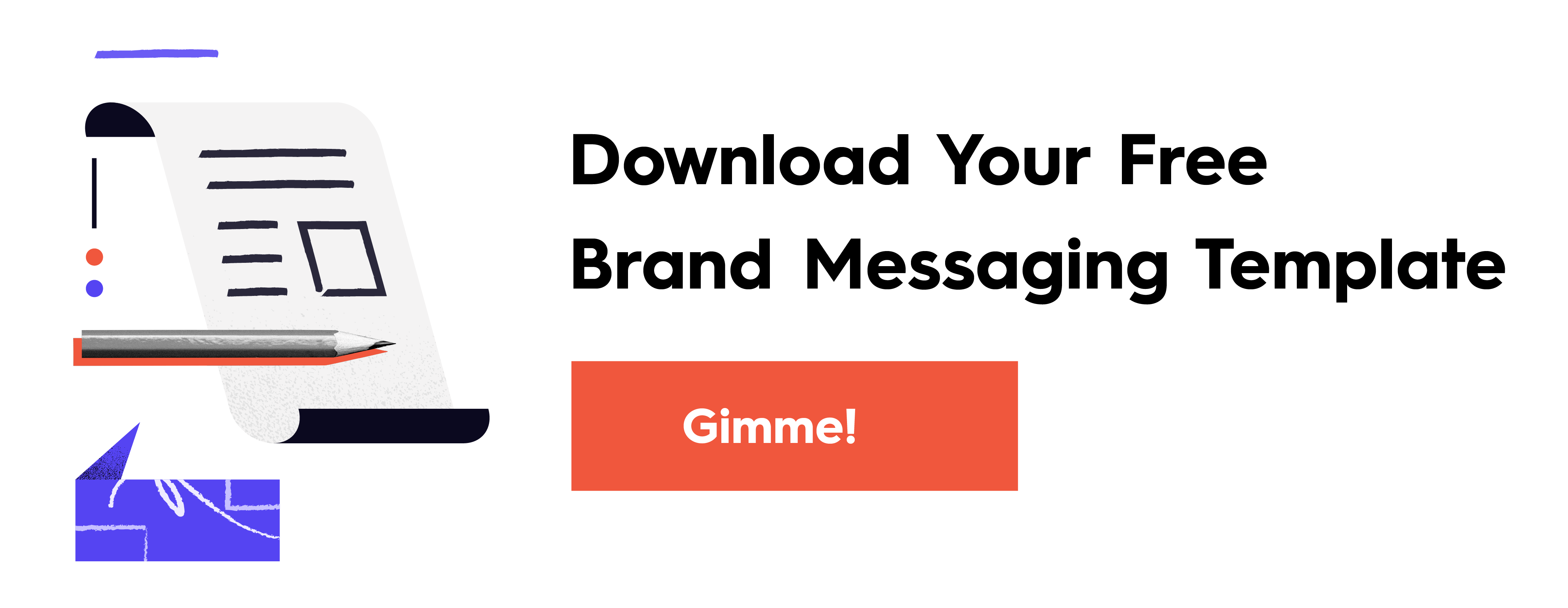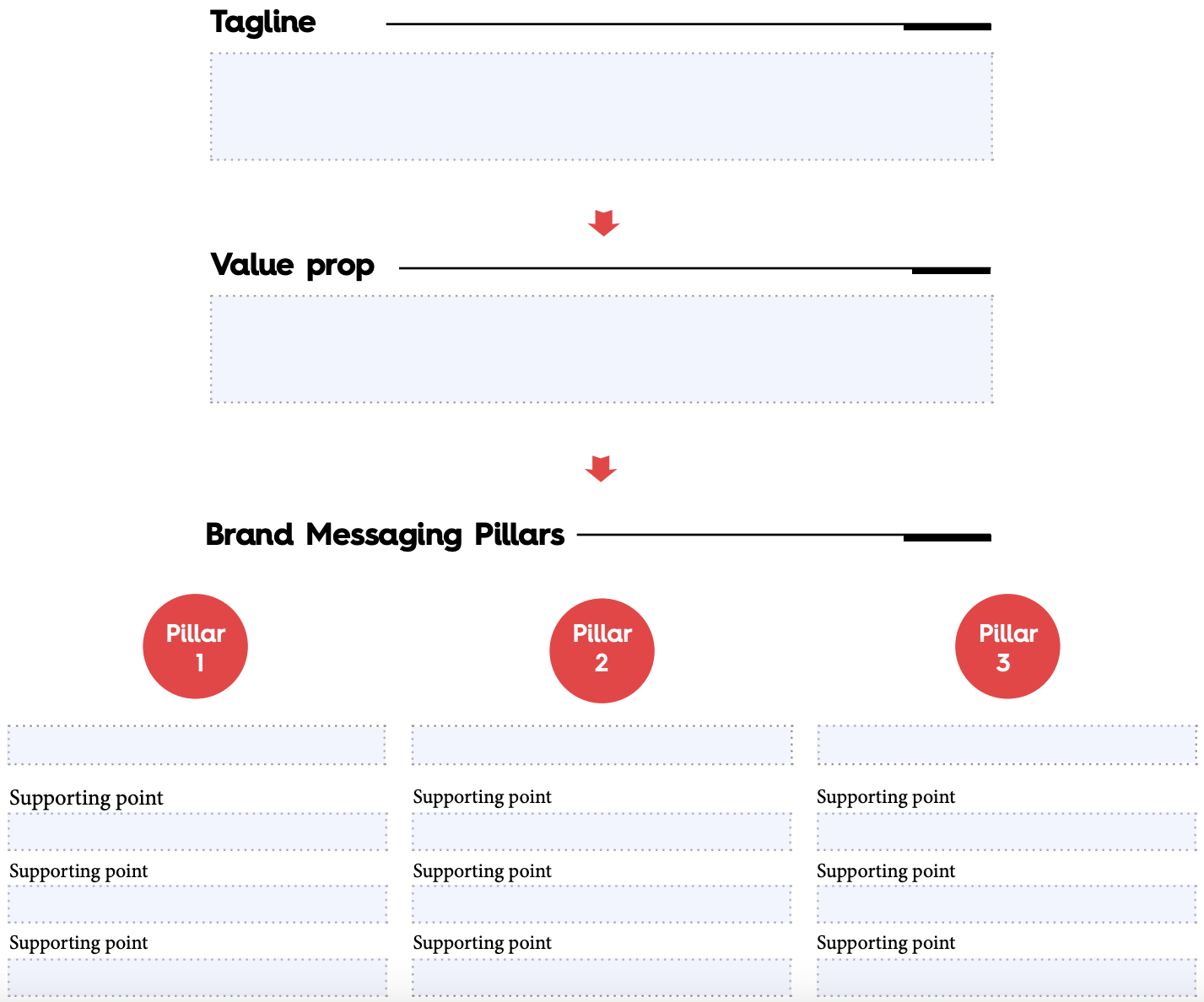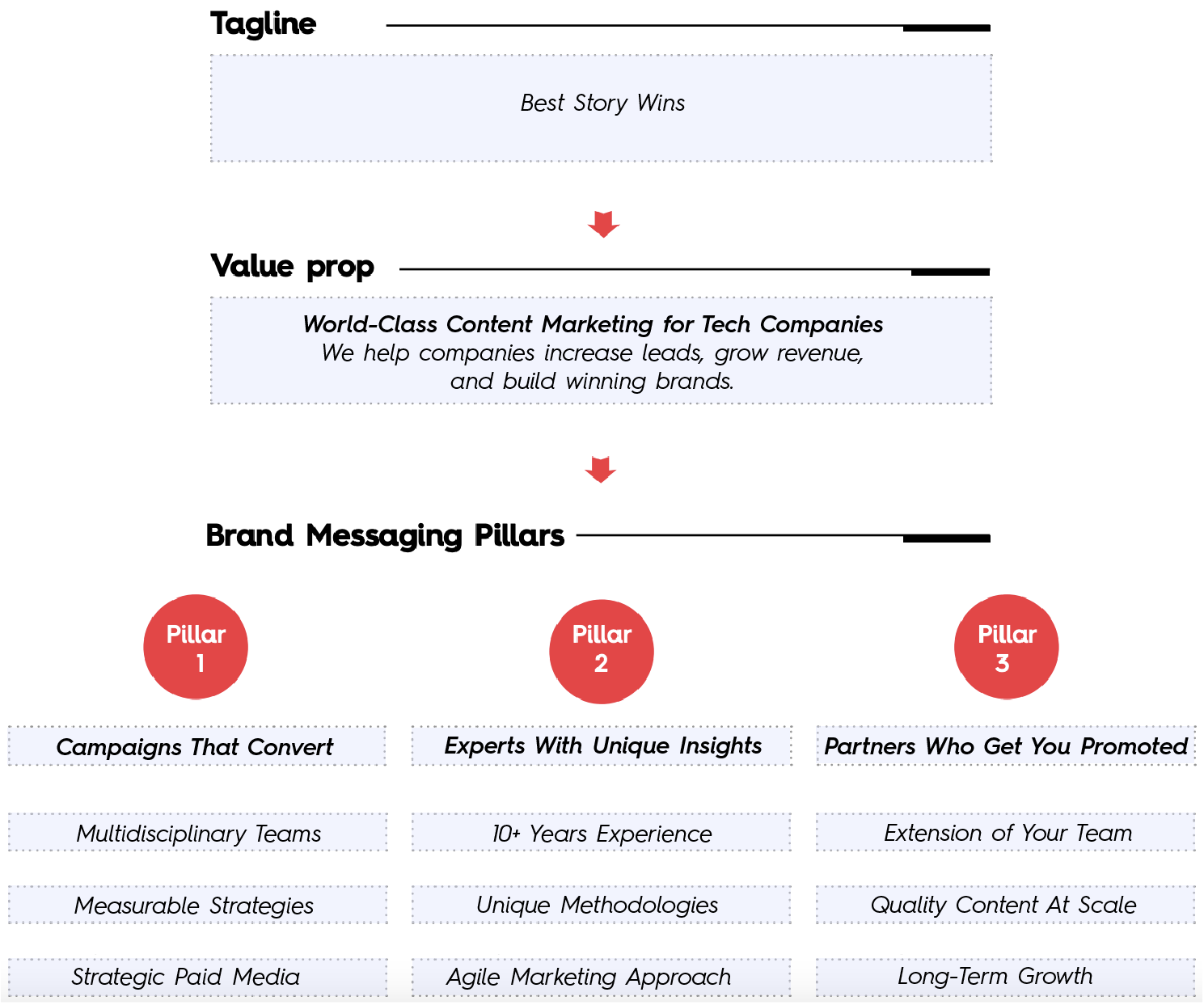Telling your brand story effectively is challenging. How do you succinctly communicate who you are, what you do, and why you’re different? How do you talk about your product or service in a compelling way? How do you communicate your beliefs impactfully? And how do you tell a consistent, cohesive story (especially if there are many different content creators working on behalf of your brand)? It starts with your brand messaging.
When you can successfully articulate your brand in simple, powerful language, you can communicate effectively with the people you’re trying to reach. You can build a stronger brand journey. And, ultimately, you can convert more people.
Unfortunately, it’s clear that many brands don’t have a solid brand messaging framework. Hence, we see lackluster value props, murky selling points, and other weak messaging in marketing materials everywhere. Luckily, you can avoid this fate.
Today, we’re going to walk you through the key elements of brand messaging, help you craft each element, and share our best tips to tell your brand story far and wide. (Even better, we’re giving you a free interactive PDF template to make it easier.)
So, whether you need to refine your current messaging or start from scratch, this is the guide you need to do it easily and efficiently.

What Is Brand Messaging?
Brand messaging is a carefully constructed framework comprised of your:
- Tagline: A short phrase that communicates your brand promise, personality, and positioning.
- Value proposition: A succinct explanation of both the functional and emotional benefits your product or service provides to your customer.
- Brand messaging pillars: 3-5 story pillars that reinforce your value prop—aka your main selling points.
We group these elements into a brand messaging hierarchy that cohesively tells a story about who you are, what you do, and how you do it better than your competition.
Brand Messaging Framework

This framework is built intentionally, from the tagline (the big idea), down to value prop (what you do), to your brand messaging pillars (how you do it). Thus, every element reinforces the other cohesively and consistently.
Why Do You Need Brand Messaging?
Whether it’s your website home page, sales brochures, or product packaging, every piece of content you create tells your brand story, whether or not you realize it. To make the most impact, you need to tell your story consistently across all touchpoints. That means reinforcing the same themes and selling points both in content and conversation.
But ask five different people on your team to describe your brand and you might hear five different answers. Without a collective understanding of your brand and a clearly articulated brand messaging framework, it’s hard to keep your story straight. This is why brand messaging matters.
By clearly articulating who you are, what you do, and how you do it, you make it easier for your team to talk about your brand consistently. You make it easier for content creators to create on-brand materials. And you create a seamless brand experience across the buyer journey. Best of all, with a fully fleshed-out framework, you have a helpful tool to brainstorm ideas around your story pillars.
What Are the Keys to Good Brand Messaging?
When it comes to brand messaging, however, we see a common problem in clients across industries. They assume that their brand messaging works because it’s documented on paper. Nope. Brand messaging is effective when it hits all three of these marks:
- Clarity: Be concise and direct. Don’t try to dazzle people with fancy language or high concepts. Trying to combine too many ideas into one story pillar—or pack a ton of flowery language into your value prop—can actually backfire. Keep it simple and impactful.
- Consistency: Your brand messaging framework ladders up from story pillars, to your value prop, to your tagline, creating a holistic messaging ecosystem. For this reason, you need to carry consistent themes up and down the ladder. The larger story you’re telling should make sense as a whole, reinforced by each piece of messaging. Don’t try to shoehorn random selling points into your story pillars. Instead, choose a few main themes that connect.
- Emotion: Whether you’re in B2B or B2C, people’s purchasing decisions are driven by emotions. Draft emotional language that excites them, or speaks to the future emotional state your brand promises (e.g., relief, joy, comfort).
Tip: Build out your marketing personas to map your customers’ needs, wants, and challenges. These will help you identify the emotions your brand messaging should reinforce.
How to Create Your Brand Messaging Framework
You may have a version of your brand messaging framework—or pieces of it—already documented. If it’s been a while, however, gather your brand team and discuss each element in detail. Once you have each element articulated, it’s important to visualize it so that content creators can see how each tier influences the next.
That said, know that strong brand messaging doesn’t start with your tagline or value prop; it starts with understanding the core of your brand. Thus, before diving into your messaging, it’s crucial that you have a solid understanding of two things:
1) Your Brand Heart
Your Brand Heart is the articulation of your brand’s core principles: who you are and what you believe in. Without this North Star, it is difficult to act or communicate consistently. To ensure you have a firm grasp of this, download our Brand Heart workbook below to identify your purpose, vision, mission, and values.

2) Your Brand Positioning
What niche do you fill? How are you different than your competitors? This information will influence every level of your messaging. To identify this, you need to conduct market research, as well as a thorough competitive analysis. (Follow our step-by-step guide to complete a competitive analysis if you’re a noob.)
Once you’ve done that research and identified where you stand, it’s helpful to distill your positioning into a one-sentence description that explains what you do better than everyone else. We like this template from branding pro Marty Neumeier:

Articulating this succinctly helps you ensure that your brand messaging is an extension of your positioning. Once you have this locked, you can start on your messaging.
How to Craft your Brand Messaging Framework
Before you proceed, download your free brand messaging template. Then follow these steps (in order) to build your framework intuitively.
Step 1: Craft Your Value Proposition
Although the brand messaging framework ladders up from messaging pillars to the tagline, we find it helpful to start with your value prop, as it is the core of who you are/what you do.
Your value prop is simple: It explains both the functional and emotional benefits your product or service provides—the value people get from it. It specifies exactly how your brand solves a problem and why people should choose you.
An easy way to articulate this is with Steve Blank’s XYZ template:

You can also think of this as the short elevator pitch to sell your brand. (Many brands even have their value prop as the first blurb on their homepage.) For this reason, you may format it as one or two lines—whatever works for you.
At Column Five, we listed out the functional and emotional benefits of our company, identified the recurring themes, and distilled it into this value prop:
World-Class Content Marketing for Tech Companies
We help companies increase leads, grow revenue, and build winning brands.
Remember: However you articulate your value prop, these benefits will be echoed throughout your brand materials, either directly (e.g., on your homepage) or indirectly (e.g., through your blog articles). So it is important that they are truly reflective of your brand.
Tip: First, identify all of your emotional and functional benefits, then pare it down to the most significant. Write a long paragraph that outlines what you want to say, then continue to iterate to distill it into a few sentences. For more tips, follow our guide to create an awesome value prop.
Step 2: Distill Your Tagline
This is where your inner Don Draper can really shine. Your tagline is a short, snappy summation that combines both your brand positioning and value prop. For example, think of Home Depot. They’re all about empowering DIYers, which is summed up in their tagline: “You can do it. We can help.”
For our own agency, we chose the tagline “Best Story Wins,” which encapsulates our perspective that the best marketing is the best storytelling—and we are the agency that can help you win your market with the best story.
Tip: Try to use as few words as possible (it’s a short line, not a paragraph.) Focus on emotion, too. What do you want people to feel when they read your tagline? To learn more about what makes a memorable tagline, follow our guide to write a great tagline. You can also get inspired by these great examples from brands across industries.
Step 3: Flesh Out Your Brand Messaging Pillars
Brand messaging pillars are a crucial element of your brand messaging—and a particularly useful tool for content creators. They are basically the 3-5 major themes, benefits, or selling points that make your brand unique.
As you craft your messaging, identify your three selling points, as well as the talking points that support them. One great thing about this exercise is that by distilling them down into brief talking points, you identify catchy phrases or keywords you can infuse into all of your content, whether it’s product packaging or a social media ad.
For Column Five, we narrowed down our key three selling points to:
- Campaigns That Convert
- Experts With Unique Insights
- Partners Who Get You Promoted
These are phrases/themes we infuse into our site, our proposal decks, and our brand content.
Tip: Sometimes you may have multiple selling points. Prioritize your differentiators, or consider ways to incorporate those points into others.
Step 4: Refine Your Brand Messaging
Take a final pass to tweak your brand messaging:
- Does each tier support the next?
- Is it written in your brand voice? (Here’s how to find your brand voice if you’re not sure.)
- Are there opportunities to cut, condense, or inject more emotion?
- Are benefits clear and consistent?
You may want to add additional copy/context to flesh out your story pillars if helpful. Your messaging framework is a flexible tool to adapt to your needs.
Note: If you’re stuck between taglines or versions of your value prop, consider A/B testing them through paid ads. This is a low-cost way to gain quick insight into what resonates.
As a final step, document your full brand messaging framework, so that your team can “see” how it all connects.
Column Five Brand Messaging Framework

How to Use Your Brand Messaging Framework
Once you have your beautiful brand messaging, it’s time to put it to use.
- Include it in your brand guidelines. Introduce the messaging, and make sure everyone is on the same page. If you don’t have them, follow our guide to create brand guidelines to ensure your content is consistent.
- Use it to brainstorm ideas. Any time you create a piece of content, you should be able to justify how it supports your brand story. We find it especially helpful to brainstorm around specific messaging pillars, as a single pillar can easily become an entire batch of content. For example, if you’re a cookie company and one of your differentiators is “distinct flavors,” you might create:
-
- A spotlight on the tastemakers who come up with your flavors
- A deep dive into the ingredients you use
- A #tbt post on the first flavor you ever created
- A contest to vote on the next flavor
- A roundup of seasonal flavors
- A quick data visualization for Instagram that shows the popularity of different flavors
-
- Clarify messaging for each stage of the buyer’s journey. To make your messaging effective, you need to say the right thing at the right time. Find out how to map your buyer’s journey to clarify messaging and identify gaps in your content.
- Write for conversion. You don’t want to come on too strong (or too early in the buyer’s journey), but there are many opportunities to nudge people along the path to purchase. Follow our tips to write compelling copy to up your game across the board.
Remember: Brand Messaging Is Just One Storytelling Tool
Beyond copy, there are plenty of ways to tell your brand story. The more tools you have, the better your story will be. For more ways to engage people through content:
- Make sure your visual identity accurately reflects your brand. Use our handy checklist to design a comprehensive identity.
- Use culture marketing to attract more people. Whether it’s customers or talent, find out how culture marketing can help you create impactful content.
- Mix up your content. Start with these 7 ideas tell your brand story if you’re looking to experiment.
And if you need help at any stage, don’t be afraid to bring in extra support. If that’s where you’re at, use our tips to find a creative agency, or hit us up. We’d love to help your brand succeed.







Wow really amazed by your content.
Thank you so much. We try to be the resource we wish we’d had.